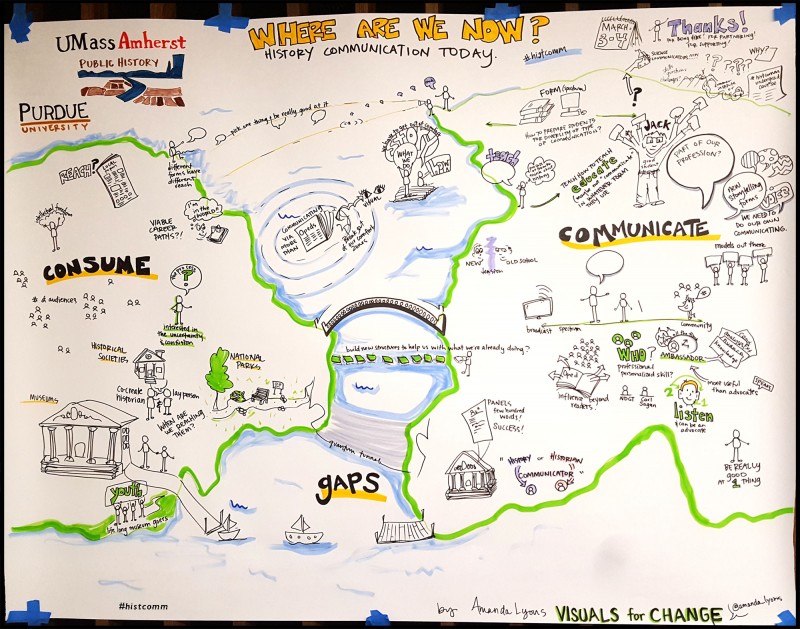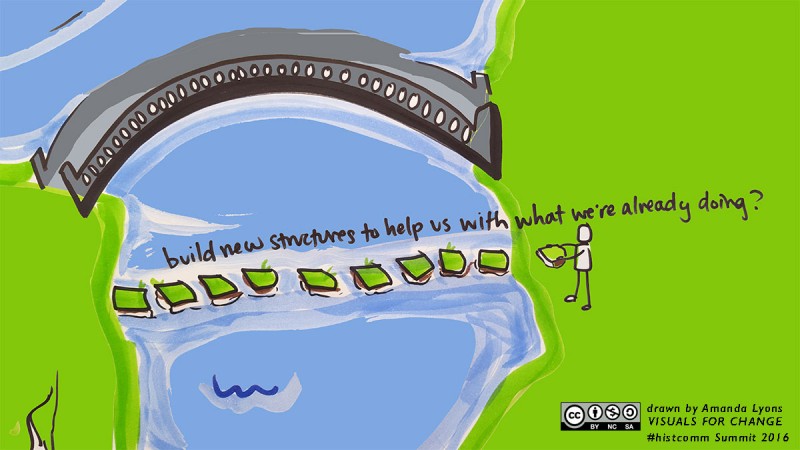Building an interdisciplinary discipline
27 April 2016 – Jason Steinhauer

Amanda Lyons of Visuals for Change was the visual note-taker at the March 2016 history communicators summit at the University of Massachusetts Amherst. Image credit: Amanda Lyons
When I put the words “history” and “communication” together nearly two years ago, I never imagined it would elicit as much discussion and controversy as it has. Some have asked whether history communication is just public history—or an extension of public history. Others have suggested it is what all historians do already. It is also what some journalists do. And documentary filmmakers. In fact, history communication as I envision it intersects all of these disciplines and more, but is bounded by none of them. Bringing this expertise under one umbrella has been part of the agenda.
Recent interdisciplinary conversations have challenged our assumptions about what history communication is and how it needs to move forward. A March 2016 summit at the University of Massachusetts Amherst laid these questions on the table before academic historians, public historians, journalists, and filmmakers. Moreover, panels at the National Council on Public History conference in April 2015 and March 2016 and at the American Historical Association conference in January 2016 have offered opportunities to learn from historians about existing initiatives and gain feedback from students about what they wish to do with their careers. I also learned a lot from students and faculty at Wayne State University during my visit there in February. All have been instrumental in fleshing out what history communication in the twenty-first century is and could be.
My original intention was to help solve a particular challenge, namely the disconnect between the vast amounts of historical scholarship produced within the academy and cultural institutions such as mine, and non-experts. Bridging this gap was—and remains—paramount among my motivations for history communicators, though there are others.
There are numerous barriers to accessing new historical scholarship, among them pricey journal subscriptions, articles behind pay walls, jargon, and lack of attention from the popular press. Museums, national parks, libraries, historic sites, films, and classrooms are some of the venues where non-experts encounter historical scholarship but increasingly they also encounter it on Wikipedia and in Google Doodles, in books by media personalities, in popular movies and theater, including Lincoln and Hamilton: An American Musical, and on social media platforms, such as Reddit, Twitter, and YouTube. New modes continue to emerge.

Image credit: Amanda Lyons
We do not uniformly prepare our history students to work in all these arenas. Not all masters and PhD students learn to design or write for the Web. Not all receive media training or are pushed to experiment with storytelling through theater and film. Not all practice using creative tools to disseminate scholarship or learn how to exploit social media.
Not all students wish to learn these things. But in my anecdotal canvassing of masters students and PhD candidates, there is wide interest in being introduced to these concepts and a wide discrepancy on how much–if any–of this is currently covered in existing programs. So while some historians may, indeed, be doing these things in a number of professional settings, cultivating such a well-rounded literacy in the next generation under the term that we call history communication is the near-term objective.
The time is ripe to innovate, to unify these practices under the umbrella of history communication, and to enhance it with best practices from history, journalism, communications, advocacy, business, and the Web. That is where we are headed, with the University of Massachusetts Amherst and Purdue University as the willing co-pilots. Soon students at these universities will be able to take an undergraduate or graduate course titled “History Communication” in which they might:
- Take an academic journal article and turn it into a blog post, infographic, series of social media posts, or YouTube video series
- Learn to pitch journalists on a new historical work or a new history project
- Put together a fundraising proposal for a history-related project to a foundation that does not specialize in history
- Learn to brief a federal, state, or local policymaker
- Learn how to apply marketing techniques to communications about history
- Extend existing public history museum practices (such as writing label texts and designing tours and educational programming) into the digital realm and other non-traditional venues
- Become more conversant with the tools and ideas of the digital humanities, including coding, web design, and computer science
- Learn to craft a compelling historical narrative using audio and visual storytelling
- Learn to speak on camera and to the media, and to be a “history pundit”
- Integrate theater and improvisational skills into history
- Ruminate on how to be an ethical historian in today’s communications landscape
Such a course could easily be nestled within existing history or public history frameworks—or even general coursework requirements within a PhD track.
My sense in talking to students is that many would be eager for such a course—and that it would be valuable to their careers. As UMass and Purdue develop these courses, we will continue to gather insights from those doing this work on how to integrate existing expertise. We will also draw on the expertise of journalists and those working in communications, marketing, theater, film, and business to make this a truly interdisciplinary offering. We have heard that there is great interest from other schools in adopting our pilot and expanding upon it. Eventually we hope there will be history communication courses nationwide.
The formation of this new field continues to be informed by discussions within the field and beyond. I encourage you to get involved by joining the conversation on Twitter at #histcomm–and check back to History@Work (and other sites) for more pieces by participants in March’s history communication summit at UMass. Nearly two years since I first introduced the idea, and after nearly a year of public conversation, the first significant deliverable is in sight. Coming soon in 2017: a new course in history communication!
~ Jason Steinhauer is a public historian at the Library of Congress and creator of the term and concept “history communicators.” For 2016 he is also a Visiting Fellow at the University of Massachusetts Amherst. On Twitter: @JasonSteinhauer.




YES YES YES YES! I’ve been saying this for the last five or six years, history and related disciplines are need to think outside of their departments and prepare their students for careers and futures that are beyond traditional, research base academic positions. Museums, historic sites, and more need people who have skills that be applied to a variety of areas.
I disagree that it should wait until the PhD level, though. We should be looking at public history programs in undergrad and postgraduate levels, too. Those students are also entering the workforce and need those skills now. I have been lucky in the past to have interns that still have a year or two left and I’m able to say, if you can, build out!
I cannot tell you how relieved I am that this conversation is picking up steam. I felt so alone for ages with my history is interdisciplinary banner.
Thanks so much! Just to clarify: the two pilots will be at the undergraduate level (Purdue) and the masters level (UMass). so we agree — no need to wait for the Ph.D.!
I read this article with interest because this is what I do – I am currently the Director of Communications for the C&O Canal Trust, and have worked with a variety of other museums and history organizations. My degrees are in Communications – I have a love of history that got me into this niche. My comment would be that there are not many jobs out there for the “history communicator”. Only the largest organizations seem to have them, and they are almost always in Marketing/Public Relations departments. I would love to see this field expand, but with declining budgets, it doesn’t seem likely. Additionally, I have run into curatorial staff and historians being so tied to their facts that any sort of interpretation for the public done by Marketing/PR professionals is seen as “dumbing down”. Perhaps training historians/curators in communications techniques is the answer. As meaningful storytelling and hands-on interpretation gains prominence in the field, it would be valuable for history students to learn how to present materials in a variety of media. I’d love to be a part of any future conversations about this, however! Very thought-provoking!
Hi Heidi! Great comment. My one quibble is, in fact, that I think there is a demand for “history communicators” and growing. I just had a meeting with a major organization interested in this, have several more that are seeking to create positions or fellowships, and smaller organizations are looking at internships or other such programs to begin to build capacity. the interest among grant-making organizations is huge as well — and the fact that it is interdisciplinary means funding can come from not solely history funders. so i’m an optimist! there’s lots on the horizon. you should stay in touch on LinkedIn: https://www.linkedin.com/groups/8355556
I’m glad to hear the field is growing! Just requested to join LinkedIN. Looking forward to further discussion on this topic!
Jason, thank you for your work on this. My undergraduate degree is in journalism/mass communication; masters and PhD work in history. I have always believed that my success in public history is attributable in large part to my communications background. It is a message I give to students every chance I get. I hope we’ll be able to bring a history communicators course to the colleges in my area soon.
that’d be great! we’re hoping that once the pilots are off the ground at UMass and Purdue, others will take the model and run with it. i know one upstate university is definitely interested. would be great if UR, Nazareth, St Bonnie’s, etc, got on board. maybe you can help us make the connections?